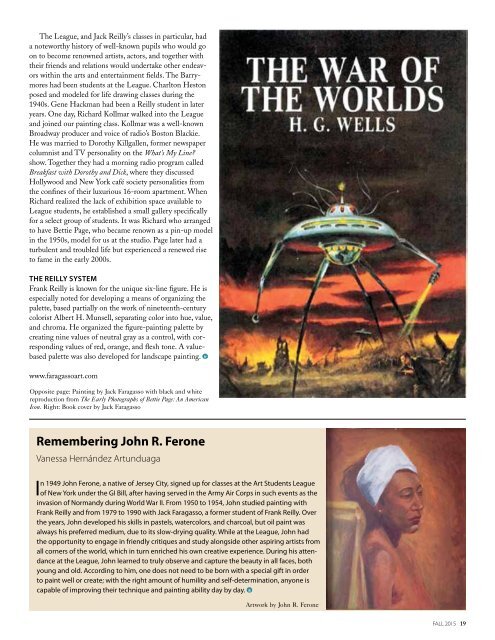League
LinkClick
LinkClick
You also want an ePaper? Increase the reach of your titles
YUMPU automatically turns print PDFs into web optimized ePapers that Google loves.
The <strong>League</strong>, and Jack Reilly’s classes in particular, had<br />
a noteworthy history of well-known pupils who would go<br />
on to become renowned artists, actors, and together with<br />
their friends and relations would undertake other endeavors<br />
within the arts and entertainment fields. The Barrymores<br />
had been students at the <strong>League</strong>. Charlton Heston<br />
posed and modeled for life drawing classes during the<br />
1940s. Gene Hackman had been a Reilly student in later<br />
years. One day, Richard Kollmar walked into the <strong>League</strong><br />
and joined our painting class. Kollmar was a well-known<br />
Broadway producer and voice of radio’s Boston Blackie.<br />
He was married to Dorothy Killgallen, former newspaper<br />
columnist and TV personality on the What’s My Line?<br />
show. Together they had a morning radio program called<br />
Breakfast with Dorothy and Dick, where they discussed<br />
Hollywood and New York café society personalities from<br />
the confines of their luxurious 16-room apartment. When<br />
Richard realized the lack of exhibition space available to<br />
<strong>League</strong> students, he established a small gallery specifically<br />
for a select group of students. It was Richard who arranged<br />
to have Bettie Page, who became renown as a pin-up model<br />
in the 1950s, model for us at the studio. Page later had a<br />
turbulent and troubled life but experienced a renewed rise<br />
to fame in the early 2000s.<br />
The Reilly System<br />
Frank Reilly is known for the unique six-line figure. He is<br />
especially noted for developing a means of organizing the<br />
palette, based partially on the work of nineteenth-century<br />
colorist Albert H. Munsell, separating color into hue, value,<br />
and chroma. He organized the figure-painting palette by<br />
creating nine values of neutral gray as a control, with corresponding<br />
values of red, orange, and flesh tone. A valuebased<br />
palette was also developed for landscape painting.<br />
www.faragassoart.com<br />
Opposite page: Painting by Jack Faragasso with black and white<br />
reproduction from The Early Photographs of Bettie Page: An American<br />
Icon. Right: Book cover by Jack Faragasso<br />
Remembering John R. Ferone<br />
Vanessa Hernández Artunduaga<br />
In 1949 John Ferone, a native of Jersey City, signed up for classes at the Art Students <strong>League</strong><br />
of New York under the GI Bill, after having served in the Army Air Corps in such events as the<br />
invasion of Normandy during World War II. From 1950 to 1954, John studied painting with<br />
Frank Reilly and from 1979 to 1990 with Jack Faragasso, a former student of Frank Reilly. Over<br />
the years, John developed his skills in pastels, watercolors, and charcoal, but oil paint was<br />
always his preferred medium, due to its slow-drying quality. While at the <strong>League</strong>, John had<br />
the opportunity to engage in friendly critiques and study alongside other aspiring artists from<br />
all corners of the world, which in turn enriched his own creative experience. During his attendance<br />
at the <strong>League</strong>, John learned to truly observe and capture the beauty in all faces, both<br />
young and old. According to him, one does not need to be born with a special gift in order<br />
to paint well or create; with the right amount of humility and self-determination, anyone is<br />
capable of improving their technique and painting ability day by day.<br />
Artwork by John R. Ferone<br />
FALL 2015 19


